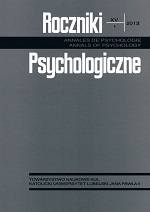Wybrane sposoby analizy autonarracji w diagnozie klinicznej na przykładzie paranoicznego zaburzenia osobowości
Self-narrative analysis methods in clinical diagnosis: The example of paranoid personality disorder
Author(s): Emilia SorokoSubject(s): Psychology
Published by: Towarzystwo Naukowe KUL & Katolicki Uniwersytet Lubelski Jana Pawła II
Keywords: paranoid personality disorder; clinical diagnosis; self-narrative; analysis of narratives; narrative psychology; paranoiczne zaburzenie osobowości; diagnoza kliniczna; autonarracja; analiza narracji; psychologia narracji
Summary/Abstract: The article is aimed at presenting the usability of some aspects of self-narrative analysis in clinical diagnosis. Clinical diagnosis concerns not only the identification of nosological categories, mechanisms of psychopathology, or etiology, but also familiarity with patients’ self-experience. It is assumed that the patient’s narrative is a psychological phenomenon in itself; it is a way of construing and re-experiencing his or her disorder. Therefore, self-narrative analysis is expected to lead to an understanding of how psychopathology is construed in language. As the leading theoretical approach, the model of narrative development proposed by Salvatore, Dimaggio, & Semerari (2004) was chosen. In order to illustrate narrative analysis, examples of paranoid personality self-narrative accounts are presented.
Journal: Roczniki Psychologiczne
- Issue Year: 16/2013
- Issue No: 1
- Page Range: 9-35
- Page Count: 26
- Language: Polish

